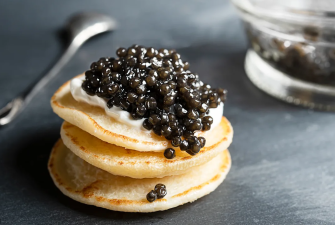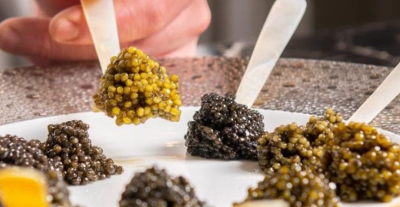Caviar Is Back on Menus: A Luxury Comeback
Caviar, known as "soft gold on the tip of the tongue," combines deliciousness with luxury, leaving a lasting impression. As one of the world's three most precious delicacies, its unique taste and nutritional value have made it a star on the dining table.
Caviar, known as "soft gold on the tip of the tongue," combines deliciousness with luxury, leaving a lasting impression. As one of the world's three most precious delicacies, its unique taste and nutritional value have made it a star on the dining table.
Caviar Ingredients and Craftsmanship
The production of this luxurious delicacy, known as "soft gold," is a true art. It is carefully crafted from the roe of naturally mature sturgeons from specific sea areas, meticulously crafted using ancient and complex techniques. Among the many sturgeon species, only the roe of the Beluga, Osetra, and Sevruga sturgeons, found in the Caspian Sea south of Russia and north of Iran, is used to create the precious caviar we are familiar with.

Grading Sturgeon Caviar
Grading sturgeon roe is crucial in the caviar production process. The grade directly determines the taste and value of the caviar. Typically, sturgeon caviar is graded based on a comprehensive evaluation of its size, color, texture, and taste. Only sturgeon roe that has undergone rigorous screening and reached a certain grade can be used to make high-quality caviar.
Three species of wild sturgeon are used to make high-quality caviar. They are categorized into different grades based primarily on their spawning age. These three surgeons are:
- Beluga sturgeon
- Osetra sturgeon
- Sevruga sturgeon
Only roe from these three species, after rigorous screening, is used to make top-quality caviar.
Sevruga sturgeon
Sevruga sturgeon is the most common of the three sturgeons. Its caviar is classified as third-grade, but it also takes seven years to mature. This means that roe must be harvested after at least seven years. Sevruga sturgeon roe is plump, large, and gray-black in color, making it highly valued for its rich flavor.
Osetra sturgeon
Its roe age is nearly double that of Sevruga sturgeon, at approximately 12 to 14 years. At this stage, the Osetra sturgeon can be dissected and its eggs harvested. Its roe is gray-brown with a black-gold sheen, giving it a distinguished appearance. While not as plump and round as the shimmer sturgeon's, its flavor is unique, reportedly nutty, making it a popular choice for culinary professionals.
White sturgeon
The roe of the white sturgeon is the highest quality of all sturgeons.
However, it also takes the longest to mature. White sturgeons typically reach sexual maturity and spawn after 18 to 20 years. White sturgeon roe varies in color, including white, light gray, and gray-black, each color representing a different quality. White sturgeon roe is also large, plump, and has a delicious flavor.
However, the white sturgeon is more valuable than the other two species due to its longer lifespan. Due to the current booming fishing industry, white sturgeons are often caught before they are old enough to produce eggs.

Tasting Techniques and Pairings
When tasting caviar, first scoop a small amount onto your tongue with a spoon. Savor its delicate, smooth texture and captivating aroma. The sweet, fresh flavor lingers long after swallowing, leaving a lasting aftertaste. Furthermore, the food you pair caviar with profoundly influences its taste, making choosing the right pairing crucial.
Caviar is typically served with a small spoon made of shell, ivory, or wood. Eating it directly ensures the caviar's original flavor is fully realized. Pairing it with a glass of champagne is a classic pairing that will elevate the experience to the next level.
